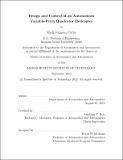Design and control of an autonomous variable-pitch quadrotor helicopter
Author(s)
Cutler, Mark Johnson
DownloadFull printable version (51.85Mb)
Other Contributors
Massachusetts Institute of Technology. Dept. of Aeronautics and Astronautics.
Advisor
Jonathan P. How.
Terms of use
Metadata
Show full item recordAbstract
The aerospace community, particularly in academia, has seen a recent rise in the popularity of fixed-pitch quadrotor helicopters. The fixed-pitch quadrotor is popular largely because of its mechanical simplicity relative to other hovering aircraft. This simplicity, however, places fundamental limits on the achievable actuator bandwidth and the types of maneuvers possible to fly. This thesis explores the extent to which the addition of variable-pitch propellers to a quadrotor helicopter overcomes these limitations. A detailed analysis of the potential benefits of variable-pitch propellers over fixed-pitch propellers for a quadrotor is presented. This analysis is supported with experimental testing to show that variable-pitch propellers, in addition to allowing for efficient generation of negative thrust, substantially increase the maximum rate of thrust change. A nonlinear, quaternion-based control algorithm is presented for controlling the quadrotor. An accompanying trajectory generation method is detailed with an optimization routine for finding minimum-time paths through waypoints. The control law and trajectory generation algorithms are implemented in simulation and on a custom variable-pitch quadrotor. The quadrotor attitude control is performed on the vehicle using a custom autopilot. Position and attitude measurements are made with an off-board motion capture system. Several flight tests are shown with a particular emphasis on the benefits of a variable-pitch qaudrotor over a standard fixed-pitch quadrotor for performing aggressive and aerobatics maneuvers. To the best of the author's knowledge, this work marks the first documented, autonomous variable-pitch quadrotor built for agile and aggressive flight.
Description
Thesis (S.M.)--Massachusetts Institute of Technology, Dept. of Aeronautics and Astronautics, 2012. Cataloged from department-submitted PDF version of thesis. This electronic version was submitted and approved by the author's academic department as part of an electronic thesis pilot project. The certified thesis is available in the Institute Archives and Special Collections. Includes bibliographical references (p. 101-106).
Date issued
2012Department
Massachusetts Institute of Technology. Department of Aeronautics and AstronauticsPublisher
Massachusetts Institute of Technology
Keywords
Aeronautics and Astronautics.